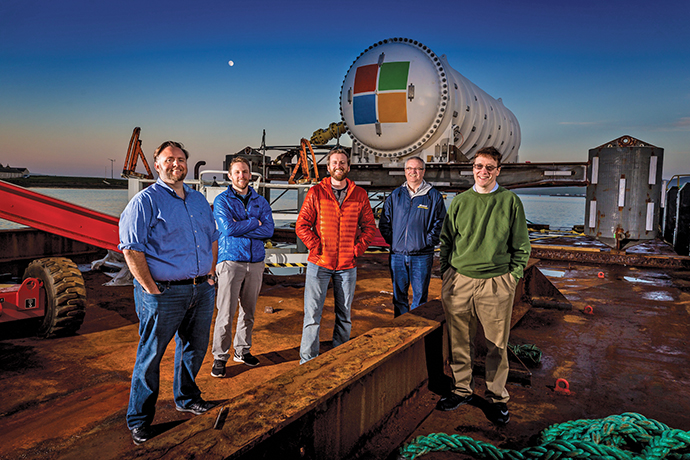Under the sea, in the data center universe, usually refers to the important global web of subsea high-speed cables, such as the 72-terabit-per-second SAEx cable soon to come ashore in Virginia Beach, Virginia — the third to land in the area and eighth in the state.
"Subsea connectivity is becoming increasingly important as evidenced by sustained and growing investment in both regional and trans-oceanic systems," said Cliff Kane, co-CEO at Cleareon, which announced in May it planned to install a subsea system that end-runs New York CIty to provide 100-gig "Wavelengths" between the transatlantic cable landing stations in Wall Township, New Jersey, and the 1025Connect colocation facility in Westbury, Long Island. "The users of these systems require true geographical diversity to support the resiliency that their customers demand."
In Europe, data center projects are pursuing a number of alternative paths to resiliency in order to reduce pressure on a grid stretched to capacity while also increasing use of renewable energy and other energy-efficiency measures. Microsoft is at the head of the class — but its underwater route includes the data center itself.
Continuing an experiment launched three years ago off the California coast, the company recently took the "locate data centers in cold places" approach one step further. It’s not only locating in Scotland, but choosing to place a data center in the sea for the next five years, receiving immediate cooling efficiency and powering it with an undersea cable that gets renewable energy from the Orkney Islands and connects the servers to the internet.
It’s called Project Natick: 864 servers, 12 racks and 27.6 petabytes of storage — enough to store 5 million movies.
"Microsoft is leveraging technology from submarines and working with pioneers in marine energy for the second phase of its moonshot to develop self-sufficient underwater datacenters that can deliver lightning-quick cloud services to coastal cities," the company explained, noting that more than half of the world’s population lives within about 120 miles of a coast. If it works in the rough seas, then shipping modular data centers to almost any location might be feasible.
Christian Belady, general manager of cloud infrastructure strategy and architecture in Microsoft’s cloud and enterprise division, said the company’s vision is to be able to deploy rapidly "anywhere on the planet as needed by our customers." He is an advocate for exploring what the company calls "the marriage of data centers and energy generation to simplify and accelerate the build-out of cloud computing infrastructure."
Key to Microsoft’s vision in Scotland was the vision of the European Marine Energy Centre (EMEC) on Orkney, established 15 years ago as a place to experiment and explore wave and tidal energy. But flexibility proved fruitful in attracting Microsoft’s interest.
"Of course, the idea of using the sea to cool a data center was not on the minds of the original designers of EMEC (who had even heard of broadband in 1999?)," an EMEC blog noted in June.
Foresight on the Continent and Stateside
Microsoft and other tech giants are accelerating investments in data center and renewable energy innovation in the UK and Europe, where the accumulation of data centers — driven in part by EU privacy laws requiring data residency in the region — are straining the power grid.
Last November, the company announced its second European wind project in the Netherlands with Vattenfall. Microsoft will purchase 100 percent of the wind energy generated from a 180-megawatt wind farm adjacent to its local data center operations in the Netherlands.
Last September, Microsoft committed to building a gas-fired power plant to power its Dublin-area data center until the region’s utility can update its grid to deal with the area’s tremendous power load requirements driven by so much data center investment from Microsoft, Google, Interxion and others.
Google in February announced plans to invest €250 million in its third building at its data center site in Saint-Ghislain, Wallonia, Belgium, where the company’s first European data center opened in 2009. Google also is investing €3 million in its first solar power facility to be installed on a data center site, featuring 10,665 solar panels.
"It’s not the first time we’ve acted on our sustainability goals in Belgium," noted Joe Kava, Google’s vice president of global data centers. "Saint-Ghislain was the very first Google data center to run entirely without refrigeration, using instead an advanced cooling system that draws grey water from the nearby industrial canal."
The renewables commitment is alive and well in the U.S. too. Iowa’s abundant wind power makes a good sustainable match for the more than 6.1 million sq. ft. of data center space under construction in Greater Des Moines by the likes of Facebook, LightEdge Solutions and Apple.
Facebook in May committed to a huge new data center in Eagle Mountain City, Utah, that it said will be powered 100 percent by net-new renewable energy through utilization of Rocky Mountain Power’s available renewable energy tariffs.
Las Vegas–based data center giant Switch in February announced the construction of the single largest solar project portfolio in the United States in concert with Capital Dynamics. The Gigawatt 1 solar project will be built in Northern and Southern Nevada and generate enough clean energy to power nearly 1 million homes — some of it feeding Switch’s data center and telecommunications operations.
"The foundation of Gigawatt Nevada is that Nevada should harness the sun the same way Alaska harnesses its oil to significantly benefit all Nevadans," said Switch CEO and Founder Rob Roy.

